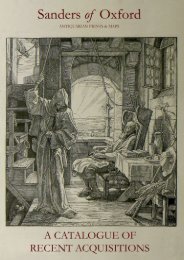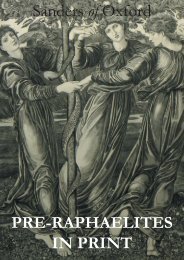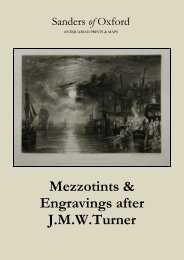«Heading» - International League of Antiquarian Booksellers
«Heading» - International League of Antiquarian Booksellers
«Heading» - International League of Antiquarian Booksellers
You also want an ePaper? Increase the reach of your titles
YUMPU automatically turns print PDFs into web optimized ePapers that Google loves.
Ex.Col.: Edgar Seligman<br />
Ex.Col.: Sydney Vacher<br />
Condition: Trimmed inside <strong>of</strong> plate, Three collectors’<br />
marks on verso (Edgar Seligman: composed <strong>of</strong> The<br />
sword <strong>of</strong> the Master-fencer, the maulstick <strong>of</strong> the painter<br />
and monogram. Sydney Vacher: composed <strong>of</strong><br />
interlocking monogram. One unidentified: interlocking<br />
monogram within a hexagon)<br />
[27605]<br />
£80<br />
British Royalty<br />
41. Right Honourable and most noble Henry<br />
Wriothsly Earle <strong>of</strong> Southampton, Baron <strong>of</strong> Litchfield,<br />
Knights <strong>of</strong> the most nob: Ord: <strong>of</strong> ye Garter.<br />
Copper engraving<br />
Simon de Passe<br />
1617<br />
Image 180 x 112 mm, Sheet 183 x 113 mm<br />
unmounted<br />
42. His Majesty George the Third King <strong>of</strong> the United<br />
Kingdom <strong>of</strong> Great Britain and Ireland, &c. &c. &c. on<br />
his favourite charger Adonis.<br />
Mezzotint<br />
James Ward after Sir William Beechey<br />
London Published Feb. y 1st 1804 by J. Ward & Co.<br />
No. 6, Newman Street<br />
Image & Plate 643 x 552 mm, Sheet 752 x 588 mm,<br />
Inscription Plate 50 x 552 mm<br />
The engraved inscription on a seperate plate.<br />
Henry Wriothesley, 3rd Earl <strong>of</strong> Southampton (1573-<br />
1624). A favourite <strong>of</strong> Elizabeth I, Southampton had<br />
become earl two days before his eighth birthday. A<br />
lover <strong>of</strong> literature, he is the only known patron <strong>of</strong><br />
Shakespeare, and in 1593 Shakespeare dedicated the<br />
witty and erotic poem Venus and Adonis to him.<br />
Southampton's tempestuous relationship with the Queen<br />
culminated in his involvement in the Essex rebellion in<br />
1601 with his close friend the Earl <strong>of</strong> Essex. He was<br />
condemned to death when the rebellion failed, but his<br />
punishment was commuted to life imprisonment and he<br />
was released by James I. Southampton was known at<br />
court for his flamboyant appearance, particularly his<br />
auburn hair which he wore long.<br />
Simon De Passe (c.1595-1647) was the son <strong>of</strong><br />
prominent Dutch engraver and publisher Crispijn Van<br />
De Passe the Elder. His father was the founder <strong>of</strong> a<br />
distinguished publishing house in Cologne that<br />
produced portraits <strong>of</strong> European nobility and religious<br />
and other prints. The family were forced to leave<br />
Cologne because <strong>of</strong> their Anabaptist faith. They moved<br />
to Utrecht, and in 1616 Simon settled in London where<br />
he established for himself a successful portrait<br />
engraving practice. He contributed portraits to Henry<br />
Holland's Baziliologia (1618) and made a number <strong>of</strong><br />
portraits <strong>of</strong> the royal family, noblemen and scholars. In<br />
1624, he moved to Copenhagen as royal engraver to the<br />
king <strong>of</strong> Denmark, a post he held for the rest <strong>of</strong> his life.<br />
Hollstein 117, O'Donoghue 4, Franken 884, Hind<br />
II.269.54<br />
King George III (1738-1820), Reigned 1760-1820 was<br />
the eldest son <strong>of</strong> Frederick, Prince <strong>of</strong> Wales, and the<br />
first Hanoverian King to be born and bred in England.<br />
His reign from 1760 was one <strong>of</strong> the longest and most<br />
eventful in modern times. From 1788 he suffered from<br />
recurrent attacks <strong>of</strong> ill health, perceived by<br />
contemporaries as madness, which were probably<br />
symptoms <strong>of</strong> porphyria. His illness led him to withdraw<br />
from public life and the establishment <strong>of</strong> the Regency in<br />
1811. However, it was only in his weakened state that












